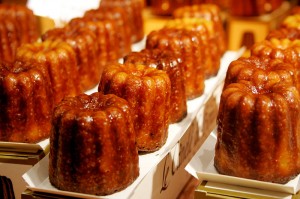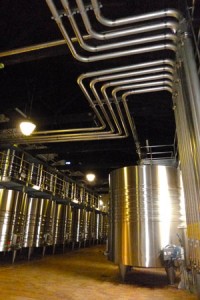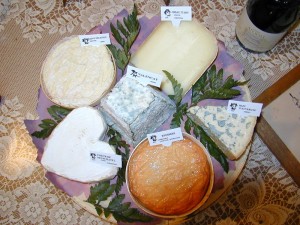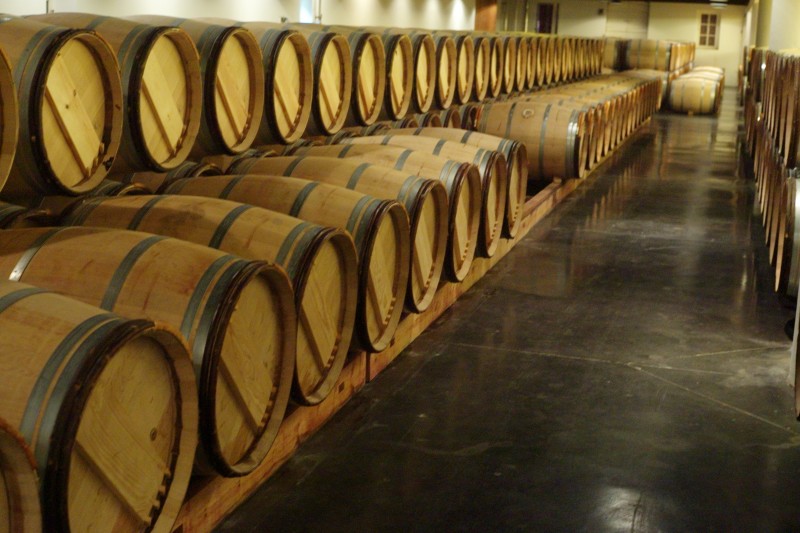
Sylvie dips her nose into the bulb of a luminous glass having a shallow puddle of crimson liquid at its bottom. “Poil de brebis!” she calls out, thrilled at her sudden inspiration.
The other dozen of us in the bright classroom roar. Even our host chuckles. He’s never heard anyone describe the smell of a distinguished Château Lynch-Bages wine as anything like sheepskin.
Good thing he has a sense of humour. Dégustation is a big deal in Bordeaux, be it in the tasting of wine or food. And Bordeaux is precisely where my husband and I find ourselves in our next bid to explore France beyond our home in the Côte d’Azur. Bordeaux, the hedonist’s paradise.
Our articulate and engaging young host asks his attentive classroom what else we smell in our glasses before the agitation. Blackberries, someone calls out. Prunes. Roses. Alcohol – yes, a good whiff of pure alcohol.
Inside this modern classroom on Château Lynch-Bages’ manicured estate, Philippe and I, along with our Quebecois artist friends Jacques and Sylvie and a handful of Benelux enthusiasts, are deep into the second step of wine tasting: the appreciation olfactive. We’ve already discussed the appreciation visuelle and its concepts of intensité and fluidité and whether the wine was a jolly, cherry red or a more dignified brick colour.
Now we spin our glasses to bring out the heavier scents in the wine and again dip our noses into the glass vessels. Anise. Toast. Moss.
“Ça sent la mouche!” our friend Sylvie calls out. It smells like flies.
Where do these Canadian come up with their descriptions? our affable French host wonders. Little does he realise Sylvie hasn’t taken a sip. She’s a virtual teetotaler.
The seduction is nearly complete, our host says. Next is the appreciation gustative. We learn about the attaque (the first 1 – 2 seconds as the wine enters your mouth), the middle of the mouth (5 – 10 seconds of swilling the wine around in your mouth, preferably after slurping in a bit of air), and the finale (the lasting effects, whether from swallowing or spitting).
I execute the attack. The word that comes to mind is wet. I crack my lips in an attempt to slurp the tiniest wisp of air into my mouth without dribbling a stream of burgundy fluid down my chin. Success.
But now what? There’s hardly enough room in my mouth to swill around the liquid and the air at the same time. So I sit in my chair, a motionless pufferfish, trying not to giggle as the wine explodes in my mouth into a festival of fruit and tannin and then a growing bitterness. My eyes widen. Other tasters begin suggesting how close this wine is to a perfect équilibre according to its acidité, rondeur and tanins. At last, amid the chatter, I can swallow. Loudly.
The first wine in this Château Lynch-Bages blind tasting was purple and punching with alcohol. Ten seconds in my mouth turned it into steel wool. It was a 2012, basically the stuff occupying the cedar barrels downstairs in the estate’s shed. By the fourth glass, we’ve discerned a wine that belongs pretty squarely at the bull’s-eye of our equilibrium chart. It’s the estate’s 1999 Grand Cru – a good year, I understand. We’re a roomful of experts.

But that’s how it goes in Bordeaux, a region bestowed with some of the world’s best wines. Around us, over 150,000 acres of neatly tended vineyards are cut by a rambling river and winding country roads. Centuries-old stone buildings dot the landscape, some polished and palatial with their grand approaches and round turrets, others crumbling around their rusted gates and scrappy wooden shutters. Throughout the ensemble rose bushes form a surprising punctuation mark at the end of many grapevine rows; roses, we learn, provide an early warning system for mildew.
How different this trip is from my only other visit to the region! My clearest memory of the place two decades ago is a white Peugeot cabriolet, a small man, a fairly heavy bit of chain and a new vocabulary word: un tracteur.
This time we’ve started out far less blunderingly. It may be damp and a bit chilly outside – the harvest is already three weeks late, we understand – but the weather hardly slows our initial touring at the winemaking meccas of Château Lynch-Bages in Pauillac and Château Giscours in Margaux. The former is a Cinquième (5th) Grand Cru Classé and the latter an even more impressive Troisième (3rd) Grand Cru Classé. These rankings were established back in 1855, when Emperor Napoléon III asked for a ranking of the country’s best Bordeaux wines based on the reputation of the château and the price of its production. The idea was to create a universal hierarchy for global visitors to the Paris wine exhibition that year.
Since then, though, no one has dared touch the classifications – with the sole exception of Château Mouton Rothschild, which was promoted from Deuxième (2nd) to Premier (1st) Grand Cru Classé in 1973, when as Ministre de l’Agriculture Jacques Chirac signed the new decree. (Rumour has it he likes very good wines.) Even though many wines now trade well wide (up or down) of their official Grand Cru classifications, a 150-year-old ranking from the time of Napoléon III remains a highly respected mark.
Our hosts at these formidable châteaux explain the winemaking process. Like how wine resting in its barrel is like freshly squeezed orange juice, its pulpy froth floating delicately at the surface. And how winemaking is like brewing a cup of coffee, as the liquids are forced to filter through heady grounds (in this case, skins and seeds and pulp). The big difference here is that winemakers percolate their increasingly intense brew through its sediment far more times than even the most serious caffeine addict could fantasize.
Of course we discuss oaks – French versus American. Naturally French is better. It cannot be cut mechanically like its brethren, so it costs more, but we learn that French oak adds better fire-based dimensions to wine, like notions of coffee and caramel. The difference in the two species comes down to a single, special molécule (the all-important “mo-leh-KUHL”) that inhabits French oak trees but apparently steers clear of its US siblings.
We learn, too, that egg whites form part of the winemaking process. Yes, raw egg whites. The fact is so bizarre that I simply have to share it. Today most houses use a listeria- and salmonella-free substitute, but at one time every barrel of wine was clarified by whipping up the whites of a few eggs and pouring their clear, sticky substance directly into the barrel through a corked hole. The egg white would sink through the wine, trapping impurities on the way to the bottom. The sludge was then cleared out of the barrel and used elsewhere in the winemaking process.
What happened to the yellows? our friend Jacques asks our current vineyard escort.

He likes the question. The area’s nuns, being of resourceful nature, would beat the yellows with flour and sugar to create little pastries called canelés and then hand them out to the poor. Indeed, I remember years ago when a Bordelais visitor to our Bellevue brought us a box of these canelés: stodgy little carmalised buns that, unfortunately, I simply adored.
At the third estate we meet Madame La Générale. She wears a hot pink, double-breasted trench coat, and her hair is pinched back into a tight bun decorated with large floral hairclips. A short, blunt-cut fringe masks the top half of her forehead.
Where have we been already? She asks.
It’s a good question, I think, so she can tailor her talk to our small group. We mention Giscours and the prestigious Lynch-Bages (which, though being a 5th, trades like a 3rd Grand Cru Classé).
Ah, she says. She pauses for effect – or to regain her stripes. (She represents a 3rd Grand Cru Classé château that’s currently trading like a 4th.)
We do things differently here, she says. (Sub-text: Our group must be disemboweled from everything we’ve already learned.) We are more traditionnelle at this château. We seek true élégance.
Escorting us to the warehouse, Madame La Générale overhears me talking to Philippe in English. She brings this breach to my attention, confirming that I’m not a native French speaker. More precisely, she targets me as l’Américaine in the group.
We file into the lofty space stacked with fragrant barrels that pervade our nostrils with a mix of ripe red berries and strong earthy oak. Our host stands before us, backlit, the silhouette of her square shoulders warning us not to move an inch further into her domain.
Here the wine ferments in oak barrels, we learn. French oak, of course. She turns to address me directly. We prefer French oak because of its élégant overtones, like crème brulée – not the noix du coco that comes from American oak.
Coconut comes from American oak barrels? Has anyone ever mentioned coconut as an aroma in a wine dégustation? Maybe alongside flavours of banana and rum?
Someone asks Madame La Générale about the eggs.
We use traditionelle methods, she confirms. The whites of somewhere between two and seven raw eggs filter through the wine of each barrel, clarifying the impurities.
No one asks about salmonella. Either we’re completely dumbfounded or afraid to perturb the general’s brittle disposition.
Madame La Générale leads us into the château’s clammy, stone cellar. It’s lit by somber yellow lights and encrusted with cobwebs and a layer of mildew that grows thicker with the elevation.
No flash on that camera! Madame La Générale barks. She continues. We, unusually for the châteaux in this area, grow our grapes on elevated lands. We have space for a true, underground cellar (even if the stone now surrounding us was imported from the other side of the river).
Tastings are a rarity at this château. Most all wine is exported as soon as it’s bottled. But somehow we have arranged a brief tasting of two cherished wines. Madame La Générale leads us into the château’s airy dégustation room and pours out a dozen small glasses of the well-guarded nectar. She pushes them haphazardly toward us across a tall serving table. Her glass remains empty.
I go through les appreciations visuelle, olfactive and gustative. The wine’s really good but I don’t want to admit it. Instead I consider the lasting side effects of salmonella.
She refills our glasses from a second bottle and slips her empty glass under the counter. No need to waste the precious brew. Promptly then she leads us back outside to the parking area.
Is there anything else we would like to see? she asks, depositing us right next to our minivan’s open doors.

Fortunately the host of our fourth and final château restores our faith in female wine dégustation hosts. She’s a young, joyful mix of information and enthusiasm, even on this, her fifth tour of the day. (Perhaps that’s why.) Château Lagrange is 100% Japanese owned with all the electronics to match. The vats housing their earliest grape juices are all stainless steel. Even the balcony that circumnavigates this lofty room of vats, and the stairway leading up to that balcony, are made of brilliant stainless steel. Stainless steel piping climbs the walls and runs along the ceiling, while two enormous flat-screen computer monitors govern the heartbeat of production inside a glassed-in office.
There’s not an eggshell to be found on this sweeping estate. Nor is there an owner. The Japanese man who purchased the estate – and therefore the only person with the right to dwell in its noble château with its formal gardens and four-story, Baroque-style turret – this Japanese man only comes to visit his Bordeaux vineyards for a few days every few years. Apparently he’s afraid of flying. Meanwhile, the head of Château Lagrange’s operations – effectively its CEO – wasn’t even allowed into the château for the first two years of his contract.
But the wine here is completely inviting. Our sociable young hostess drinks with us, presumably for her fifth time today. Dégustation offers up a good, solid équilibre of a 3rd Grand Cru Classé wine but at very reasonable prices. And still, purchases, even of a single bottle, are impossible these days. We’re all flying.

As experts in the art of wine dégustation, we now are ready to tackle the Michelin two-starred restaurant at Château Cordeillan-Bages, just down the country road from Château Lynch-Bages, where we began our education only yesterday. Our small group reassembles at 8:30 p.m. Already ten wines into the day, we are rested and hungry.
Situated in a 17th-century Carthusian monastery, Château Cordeillan-Bages’ contemporary dining room is scattered with small clusters of diners. The maître d’ parades us through this space into a separate room having at its centre a long, stately table draped in starched white linen. Three coloured glass balls line its center, simple and modern décor for the intricate feast to follow.

A menu dégustation at this sort of restaurant is an exercise in endurance. I’ve learned this the hard way. On my couple prior experiences I’ve ended up either saddened and embarrassed to turn away luscious desserts, or else completely distended. I now appreciate that you have to pace yourself. Here, for example, the warm hors d’œuvres balls that arrive at the table don’t even feature on our ten-course, printed menu.
Still or sparkling water? a waiter asks. Rule number one in these situations: Still. Always still. Bubbles take up space.
Another waiter circulates with a basket of gorgeous breads. Rule number two: Choose one roll and taste it, but don’t even think about eating it.
Various butters arrive, each with an explanation. Select one, but only a tiny bit. Remember, this is a matter of survival. You cannot eat the bread.
The first wine arrives: Graves 2011, Château Villa Bel-Air. You must drink cautiously. A waiter circulates to refill modestly drained glasses, but notice that three more empty wine glasses queue up at each place setting.
The servings continue at this pace amid a flurry of cutlery changes and propositions of more bread. Thankfully the waiter with the breadbasket never tempts me again as I’ve barely touched my first bit.
The mise en bouche (a nameless appetizer, which is delightful but in writing this note, I honestly cannot remember what it was) is followed by an oversized soup bowl of variation de chou fleur aux huitres et caviar (cauliflower whipped up like you’ve never seen it, with oysters and caviar).
Not being fond of foie gras, I suggest skipping the course – it’s all about endurance – but instead am treated to a bed of yogurt, cucumber and dill topped by shaved crab and crowned with several large bites of warm king crab leg.
The second of our wine glasses is filled with a more golden white, Bordeaux 2011, Blanc de Château Lynch-Bages, before the arrival of the chef’s twist on pain perdu. “Lost bread” is how French people normally describe what we Anglophones call French toast. Tonight’s pain perdu, though, comes not with maple syrup but with algues, fines lamelles de seiche, and bouillon au sésame grillé. Bread with seaweed, squid slivers and grilled sesame broth. It honestly ranks as one of the most flavourful and delicious things I’ve tasted in my life.
Out comes the homard bleu, petits légumes en risotto, cappuccino de corail (blue lobster, vegetable risotto and a froth of (presumably edible) coral), and somewhere in there arrives the first red, Pauillac 2002, Château Cordeillan-Bages, the restaurant’s namesake.
Philippe, I am told discretely, is skipping the next course, but I’m dying to try it: pigeonneau légèrement fumé, mousserons et rhubarb, reduction de betterave rouge. Who knew that pigeons could be something other than a nuisance? Especially when they are smoked and accompanied by hearty mushrooms, cooked rhubarb and a beetroot reduction. The fourth wine arrives, too: the glorious Pauillac 2003, Château Lynch-Bages.

A trolley circles the table, stopping at the ladies first, hoping to tempt us with the sélection de la fromagerie Xavier à Toulouse. This cheese shop, we see from the menu, is under the baton of François Bourgon, Meilleur Ouvrier de France – a title that indicates Mr Bourgon ranks among the best cheesemongers in the whole of France, a country renowned for its cheeses.
And yet I must decline, citing issues of space. The waiter places an empty white plate in front of me.
There’s a pre-dessert which is, of course, followed by the real dessert of chaud froid tout chocolat, fève Tonka, crème glacée chocolat blanc cardamome. Chocolate and more chocolate. It’s precisely the reason I skipped the cheese – even if it is now after midnight.
The marathon finishes, more than four hours later, with the impossible suggestion of coffee or tea – along with sharing plates of douceurs et friandises. Nestled beside raspberry and salted caramel chocolates are Bordeaux’s famous canelés. I take one from the plate to save for breakfast and wonder, in my satiated and saturated state, whatever they do today with all the extra egg whites.
As someone rolls me out of the restaurant, we pass a table of diners still grazing at their own endurance test. Sitting at the table alongside their parents are two young children.
Fortunately our plane departs tomorrow. Joining a seven-day tour in this style – as some do – wholly exceeds my digestive capabilities.
Anyway, this trip already has cost a pretty penny. From now on, I fear I’ll be unable to touch anything inferior to a 3rd Grand Cru Classé.

